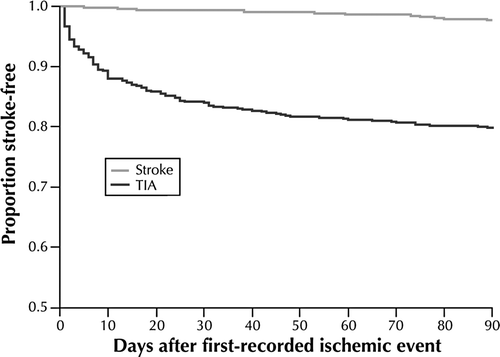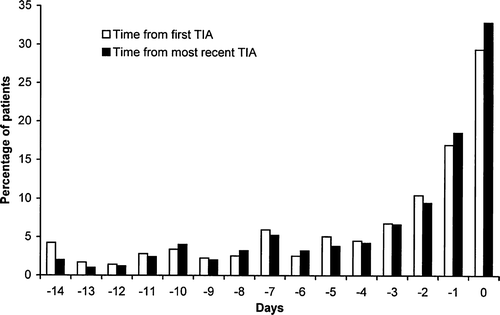Recently published guidelines recommend that carotid surgery, when appropriate, is performed within two weeks after a transient ischemic attack or a minor stroke. This represents a marked change in comparison with earlier practice, where surgery was delayed, often for months. There is reason to go further than the current guidelines and perform the operation within hours. This suggestion is discussed in relation to the principles of evidence based medicine.
When introducing new methods for treatment, the golden rule of evidence based medicine is to base it on at least two randomised trials, comparing the new method with present routine treatment. This may, however, not always be possible due to different reasons. Particularly in surgery, it may be difficult to get truly comparable populations for randomisation because the treatment modules may be difficult to standardise. The outcome may to a large extent depend on the skill of the different surgeons taking part in the study. Another obstacle for randomised studies is when the disease to be treated is uncommon, making it impossible to sample a large enough patient population for study within a reasonable time. This may be the case even if you get patients from all of Europe, all of the Americas or both.
The surgical treatment of transient ischemic attacks (TIA) or minor strokes constitutes an example of a restricted patient population. It is also impossible to make prospective studies when patients with TIA are the objects for study. Many patients experiencing their first TIA – unknown how many – do not seek medical care, as they may judge symptoms that quickly disappear as trivial. Most of the literature on the development of stroke after TIA is consequently retrospective, starting from the first stroke the patients have experienced. This makes them retrospective in relation to the TIA. In these studies, about 15 to 26% of the stroke patients have earlier experienced a TIA, up to 50% of these patients within the two days preceding the stroke Citation1–3.
Even if you want to study various treatment modules, including surgery, of patients diagnosed with TIA and more than 50% obstructed lumen of the carotid artery, the time it would take to assemble enough patients to arrive at a reliable result is prohibitive. A power analysis based on the combined two major randomized trials Citation4 and the assumption that the treatment would reduce the risk of a stroke with at least 30%, when the operation is performed within 24 hours after a TIA instead of within 2 weeks (as recommended in current guidelines), indicates that close to 2 000 patients would be required for a result with 80% power.
Two adequately sized prospective randomized studies would be necessary to obtain the required evidence according to evidence based terminology. It took 9 and 13 years, respectively, to obtain the 3 000 patients that took part in each of the two major prospective randomized studies comparing carotid surgery with medical treatment Citation5, Citation6. To obtain 2 000 patients for a treatment study with a similar rate of inclusion would take approximately 6 years or more – after the necessary preliminary discussions of methods to be used had been concluded.
Is it reasonable with a delay of 6 to 8 years before you may obtain results making it possible to formulate evidence based recommendations? The high risk of stroke within the first few days, demonstrated in the retrospective studies mentioned earlier (illustrated by & ), would mean that many patients are unnecessarily allowed to develop strokes, if the present recommendation of surgery within 2 weeks is maintained.
Figure 1. Kaplan–Meier ipsilateral stroke-free survival curves from date of first-recorded hemispheric transient ischemic attack (TIA) or hemispheric stroke (reference 3).

Figure 2. Distribution of time from TIA to stroke for patients experiencing a stroke who reported a TIA within the previous 14 days (reference 2).

Based on the results of large representative studies of stroke patients, it might be possible to advocate surgery without delay after a TIA. Only then would the full potential of carotid surgery be exploited, as effective intervention should not be delayed till after the highest risk of stroke has been passed.
The benefit or early surgery has, however, also to be judged against the risk of surgical intervention. A recent report indicated higher surgical risks with early compared to later surgical intervention Citation7. The early risk of stroke after TIA seems, however, considerably higher than the increased surgical risk with early intervention in most high risks categories of patients.
Even without the evidence from randomised studies, thus, it seems reasonable to advocate very early intervention after TIA, provided a manifest stroke can be ruled out. High risk patients with TIA should be routinely investigated on an emergency basis, aiming at carotid surgery within hours.
Present guidelines
Less than a year ago, Swedish National Stroke Guidelines were presented Citation8. It was recommended that carotid endarterectomy should be performed within 2 weeks after a transient ischemic attack (TIA) or minor stroke in patients with carotid artery atherosclerotic disease with more than 50% stenosis. This was in line with present international guidelines but represented a dramatic change of the routine handling regarding patients with TIA in Sweden in many other countries.
The clinical practice had until then been based on delaying surgery in order to avoid unacceptable high complication rates with early intervention. New knowledge had been presented and the central recommendation was to a large extent based on the combined data from two large prospective randomised treatment studies, NASCET and ECST Citation4. They showed that operation performed within 2 weeks after the TIA was clearly more effective in stroke prevention than later intervention.
However, the new policy has led to a discussion. Some surgeons are concerned with the high complication rate Citation7, while others have suggested that surgery should be performed within hours of the warning signal that a TIA constitutes Citation2. In deciding which of these attitudes that is best for the patients, we have to rely on the literature, as exemplified above. According to the above analysis early intervention ought to be preferred. The dynamics of the early period after a TIA is illustrated in the accompanying figures taken from references [2] and [3]. These results indicate the large potential of very early management.
Minor strokes
The treatment of minor strokes constitutes quite a different problem. Conflicting reports have been published regarding the risk for early stroke after a minor stroke, one study reporting the risk being about 2% Citation3, while another reported a risk of 17.9% Citation4. A study of early surgery after a minor stroke Citation7 reported that perioperative strokes occurred in 9.4%. In contrast delayed intervention was associated with a stroke rate of only 2.4%. These data do not allow a definite description of the real course after a minor stroke with or without surgical treatment. Until more reliable data from several studies are published, patients with minor strokes ought thus not to be treated in the same way as patients with TIA.
In the case of minor strokes it may also be possible to conduct prospective treatment studies, as the early symptoms are of a degree to make the patient seek medical care. This would allow an evidence based philosophy regarding the treatment of patents with minor strokes.
To sum up, in spite of insufficient evidence from prospective randomized trials, surgical intervention in the case of patients with TIA should be performed early, preferably within hours after a preceding TIA.
Patients with minor stroke should, on the other hand, be treated according to present guidelines until more evidence is gathered regarding different treatment options. For these cases it might be possible to conduct controlled randomized trials.
It would, however, be helpful if all cases of TIA, regardless of treatment, were assembled in a central register in order to gain more experience and create a better basis for future recommendations.
Patients with minor strokes might also benefit being reported to a central register. The organization of such registers could probably only be done on a national basis. It would, however, be of value to aim at international cooperation when such quality registers have started on a national basis in several countries.
References
- Johnston SC, Gress DR, Browner WS, Sidney S. Short-term prognosis after emergency department diagnosis of TIA. JAMA 2000; 284: 2901–6
- Rothwell PM, Warlow CP. Timing of TIAs preceding stroke. Time window for prevention is very short. Neurology 2005; 64: 817–20
- Eliasziw M, Kennedy J, Hill MD, Buchan AM, Barnett HJM. Early risk of stroke after a transient ischemic attack in patients with internal carotid artery disease. CMAJ 2004; 170: 1105–9
- Rothwell PM, Eliasziw M, Gutnikov SA, Warlow CP, Barnett HJM. Endarterectomy for symptomatic carotid stenosis in relation to clinical subgroups and timing of surgery. Lancet 2004; 363: 915–24
- Barnett HJM, Taylor DW, Eliasziw M, Fox AJ, Ferguson GG, Haynes RB, et al. Benefit of carotid endarterectomy in patients with symptomatic moderate or severe stenosis. New Engl J Med 1998; 339: 1415–25
- European Carotid Surgery Trialists’ collaborative group. Randomised trial of endarterectomy for recently symptomatic carotid stenosis: Final results of the MRC European carotid surgery trial (ECST). Lancet 1998; 351: 1379–87
- Rockman CB, Maldonado TS, Jacobowitz GR, Cayne NS, Gagne PJ, Riles TS. Early carotid endarterectomy in symptomatic patients is associated with poorer outcomes. J Vasc Surg 2006; 44: 480–7
- Nationella riktlinjer för strokesjukvård. 2005. Socialstyrelsen.